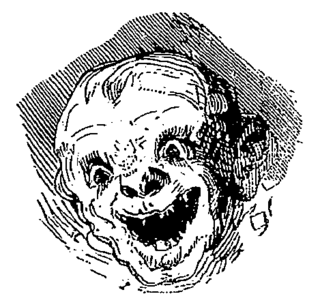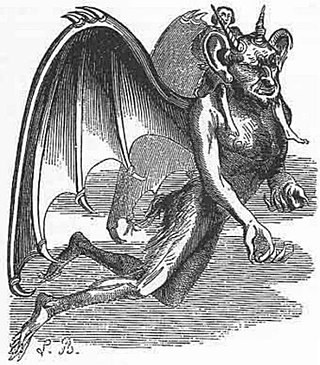
Vassago (also Vasago, Usagoo) is a demon described in demonological grimoires such as the Lesser Key of Solomon and the Book of the Office of Spirits .

Vassago (also Vasago, Usagoo) is a demon described in demonological grimoires such as the Lesser Key of Solomon and the Book of the Office of Spirits .
He is the third demon in the Lesser Key (including Thomas Rudd's variant) and is referred to as a prince "of a good nature" and of the "same nature as Agares". [1] He rules twenty-six legions of spirits, and is summoned to tell magicians of past and future events, and locate lost objects. He is one of the few spirits found in the Lesser Key of Solomon but not in Johann Weyer's Pseudomonarchia Daemonum. [2] [3]
According to Rudd, Vassago is opposed by the Shemhamphorasch angel Sitael. [4]
Vassago is mentioned in the Book of the Office of Spirits as Usagoo, appearing as an angel, "just and true in all his doings," with the powers of inciting the love of women and revealing hidden treasures, in addition to ruling twenty spirits. [5] Sloane MS 3824 mentions Vassago in invocations to summon spirits that guard treasure, [6] and in the "Experiment of Vassago" [7] and the "Experiment of Agares," both intended to capture the named spirits in crystals. [8]
Vassago is mentioned in the novel Hideaway by Dean Koontz, and in its film adaptation.
Murderer and vampire-themed cult leader Rod Ferrell used "Vassago" as a "vampire name" and burned a V representing this alias onto his victims; Ferrell did not know how to spell or pronounce Vassago's name correctly, and typically called himself "Vesago". [9]
Vassago appears as a character in the animated web series Helluva Boss (voiced by Harvey Guillén), alongside some other Goetia demons like Paimon, Stolas and Andrealphus. [10]

Bael is a demon described in demonological grimoires such as The Lesser Key of Solomon and the Pseudomonarchia Daemonum and also in the Dictionnaire Infernal. He is described as a hoarsely-voiced king with the power to make men invisible and ruling over sixty-six legions of demons. The Lesser Key of Solomon describes him as appearing in the form of a cat, toad, human, some combination thereof, or other "diverse shapes", while the Pseudomonarchia Daemonum and the Dictionnaire Infernal state that he appears with the heads of a cat, toad, and human simultaneously.

Alloces is a demon that appears in demonological grimoires such as the Liber Officiorum Spirituum, Pseudomonarchia Daemonum, and the Lesser Key of Solomon. He is described in the Lesser Key of Solomon and in the Pseudomonarchia Daemonum as a duke, taking the form of a fire-breathing, lion-headed soldier riding a horse. His purported duties include teaching astronomy, and liberal sciences, and granting familiars. He is claimed to have 36 legions of demons under his command. In the Liber Officiorum Spirituum, Alloces appears as Allogor or Algor, again a duke, but otherwise with a completely different appearance and abilities -- a spear-toting knight who answers questions, provides advice for plans, and commands only 30 legions of demons. In the duplicate entry, Alloces appears as Algor, ruled by the spirit "Orience" (Oriens), again as a knight who explains secrets, but with the additional power of garnering the favor of nobles. According to Rudd, Alloces is opposed by the Shemhamphorasch angel Imamiah.
Vine is a demon listed in demonological grimoires such the Lesser Key of Solomon Johann Weyer's Pseudomonarchia Daemonum, and Jacques Collin de Plancy's Dictionnaire Infernal.

Bifrons is a demon described in the demonological grimoires the Lesser Key of Solomon and the Pseudomonarchia Daemonum, as well as being mentioned in the Dictionnaire Infernal. These works describe Bifrons as an earl who initially appears as a monster before adopting a more human form. His duties include teaching arts and sciences, including astrology, geometry, and the properties of different plants and stones. He also moves bodies into different graves, lights candles over graves, and commands either 6, 26, or 60 legions of spirits.
The Lesser Key of Solomon, also known by its Latin title Lemegeton Clavicula Salomonis or simply the Lemegeton, is an anonymously authored grimoire on sorcery, mysticism and magic. It was compiled in the mid-17th century, mostly from materials several centuries older. It is divided into five books: the Ars Goetia, Ars Theurgia-Goetia, Ars Paulina, Ars Almadel, and Ars Notoria. It is based on the Testament of Solomon and the ring mentioned within it that he used to seal demons.

Agares is a demon described in demonological grimoires.
In demonology, Halphas is the thirty-eighth demon in the Ars Goetia in the Lesser Key of Solomon, ranked as an earl.
The Pseudomonarchia Daemonum first appears as an appendix to De praestigiis daemonum (1577) by Johann Weyer. An abridgment of a grimoire similar in nature to the Ars Goetia, it contains a list of demons, and the appropriate hours and rituals to conjure them.
Bathin is a demon described in demonological grimoires.
Bune is a demon listed in demonological grimoires such the Lesser Key of Solomon Johann Weyer's Pseudomonarchia Daemonum, Jacques Collin de Plancy's Dictionnaire Infernal, and the Livre des Esperitz.
Gamigin is a demon described in demonological grimoires such as The Lesser Key of Solomon and Johann Weyer's Pseudomonarchia Daemonum.

Paimon is a spirit named in early grimoires. These include The Lesser Key of Solomon, Johann Weyer's Pseudomonarchia Daemonum, Jacques Collin de Plancy's Dictionnaire Infernal, the Livre des Esperitz, the Liber Officiorum Spirituum, The Book of Abramelin, and certain French editions of The Grimoire of Pope Honorius ; as well as British Library, Sloane MS 3824.

Lerajie is a mighty Great Marquis of Hell who has thirty-three legions of Demons under his power. He is said to cause great battles and disputes, and makes gangrene wounds caused by arrows. He can make a lover come to him, and also send them away. He is depicted as a gallant and handsome archer clad in green, carrying a bow and quiver, in the folklore of the Bible. But his true appearance is around 5 feet tall, with shoulder length black hair and bangs. With a long shimmering red wingspan. Leraje is a demon mentioned in demonological grimoires. He appears in the Lesser Key of Solomon, Johann Weyer's Pseudomonarchia Daemonum, and Jacques Collin de Plancy's Dictionnaire Infernal.
Botis, sometimes Otis, is a demon described in the Lesser Key of Solomon and the Pseudomonarchia Daemonum as a President and an Earl who initially appears as a viper before changing into a sword-toting, fanged, and horned human who discusses matters past, present, and future; brings favor from allies and enemies, and rules 60 legions of demons. In the Munich Manual of Demonic Magic, Botis appears as Otius, and is mostly identical except that he is a preses and Count, appears in the more humanoid form to begin with, and rules only 36 legions of demons. In the Grand Grimoire, Botis appears as a subordinate of Agaliarept. According to Rudd, Botis is opposed by the Shemhamphorasch angel Lauviah.

Gaap is a demon that is described in demonological grimoires such as the Lesser Key of Solomon, Johann Weyer's Pseudomonarchia Daemonum, and the Munich Manual of Demonic Magic, as well as Jacques Collin de Plancy's Dictionnaire Infernal,

Gemory is a demon listed in demonological grimoires.

Valac is a demon described in the goetic grimoires The Lesser Key of Solomon, Johann Weyer's Pseudomonarchia Daemonum, the Liber Officiorum Spirituum, and in the Munich Manual of Demonic Magic as an angelically winged boy riding a two-headed dragon, attributed with the power of finding treasures.
Amy is a demon described in demonological grimoires such as the Lesser Key of Solomon, the Pseudomonarchia Daemonum, and in the Munich Manual of Demonic Magic; as well as Jacques Collin de Plancy Dictionnaire Infernal,
Liber Officiorum Spirituum was a goetic grimoire and a major source for Johann Weyer's Pseudomonarchia Daemonum and the Ars Goetia. The original work has not been located, but some derived texts bearing the title have been found, some in the Sloane manuscripts, some in the Folger Shakespeare Library. Each version bears many similarities to each other and to the Pseudomonarchia Daemonum and the Ars Goetia, though they are far from identical.